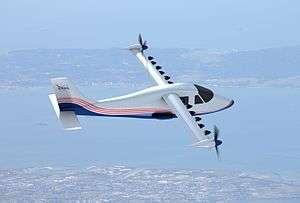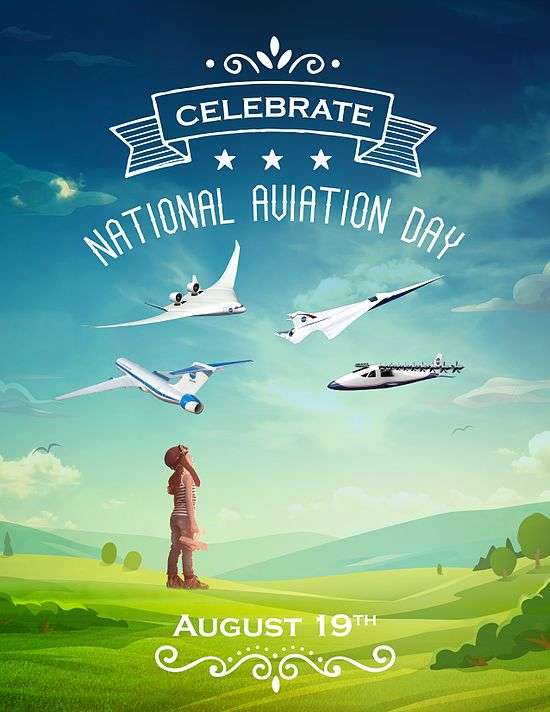NASA X-57 Maxwell
| X-57 Maxwell | |
|---|---|
 | |
| Artist concept of X-57 in flight | |
| Role | Experimental light aircraft |
| National origin | United States |
| Manufacturer | ESAero[1] |
| Primary user | NASA |
| Developed from | Tecnam P2006T |

The NASA X-57 Maxwell is an experimental aircraft being developed by NASA, intended to demonstrate technology to reduce fuel use, emissions, and noise.[2] Modified from a Tecnam P2006T, the X-57 will be an electric aircraft, with 14 electric motors driving propellers mounted on the wing leading edges.[3] The X-57 project was publicly revealed by NASA Administrator Charles Bolden on 16 June 2016 in a keynote speech to the American Institute of Aeronautics and Astronautics (AIAA) at its Aviation 2016 exposition.[4]
Design and development
The design of the aircraft grew out of a NASA project called Leading Edge Asynchronous Propeller Technology.
The X-57, NASA's first X-plane in over a decade, is part of NASA's New Aviation Horizons initiative, which will also produce up to five larger-scale aircraft. The X-57 will be built by the agency's Scalable Convergent Electric Propulsion Technology Operations Research (SCEPTOR) project, over a four-year development period at Armstrong Flight Research Center, California, with a first flight planned for 2017.[5][6][7]
All 14 electric motors will be used during takeoff and landing, with only the outer two used during cruise. The additional airflow over the wings created by the additional motors generates greater lift, allowing for a narrower wing. The aircraft, which seats two,[8] will have a range of approximately 100 miles (160 km) and a maximum flight time of approximately one hour. The X-57's designers hope to reduce by five-fold the energy necessary to fly a light aircraft at 175 miles per hour (282 km/h).[4][5]
In July 2017, Scaled Composites is modifying a first P2006T to the X-57 Mod II configuration by replacing the piston engines with Joby Aviation electric motors, to fly early in 2018. Mod III configuration will move the motors to the wingtips to increase propulsive efficiency. Mod IV configuration will see the installation of the Xperimental, LLC high aspect ratio wing with 12 smaller props along its leading edge to augment its takeoff and landing aerodynamic lift.[9]
See also
References
- ↑ Lynem, Julie (September 29, 2015). "ESAero, based in Oceano, to build NASA X-plane". The Tribune. Retrieved 29 September 2015.
- ↑ Beutel, Allard (2016-06-17). "NASA Electric Research Plane Gets X Number, New Name". NASA. Retrieved 2016-06-19.
- ↑ Button, Keith (May 2016). "Flying on Electrons" (PDF). Aerospace America. American Institute of Aeronautics and Astronautics. Retrieved 23 June 2016.
- 1 2 Prigg, Mark (June 17, 2016). "The REAL X-Wing: Nasa unveils 'megawing' X-57 Maxwell with 14 electric motors on its wing that could revolutionise travel". Daily Mail. Retrieved 17 June 2016.
- 1 2 McFarland, Matt (June 16, 2016). "NASA’s new electric plane could be a significant step toward a cleaner era of aviation". Washington Post. Retrieved 17 June 2016.
- ↑ Boyle, Alan (June 17, 2016). "NASA gets first official X-plane in a decade: Electric craft named X-57 Maxwell". GeekWire. Retrieved 17 June 2016.
- ↑ Tayag, Yasmin (June 17, 2016). "NASA Admin Charlie Bolden: X-57 Will Fly Next Year". Inverse.com. Retrieved 17 June 2016.
- ↑ Fox, Steve (26 July 2016). "Cockpit of the First All-Electric Propulsion Aircraft". NASA. Retrieved 26 July 2016.
- ↑ Graham Warwick (Jul 19, 2017). "NASA Pushing Ahead With Electric X-plane". Aviation Week Network.